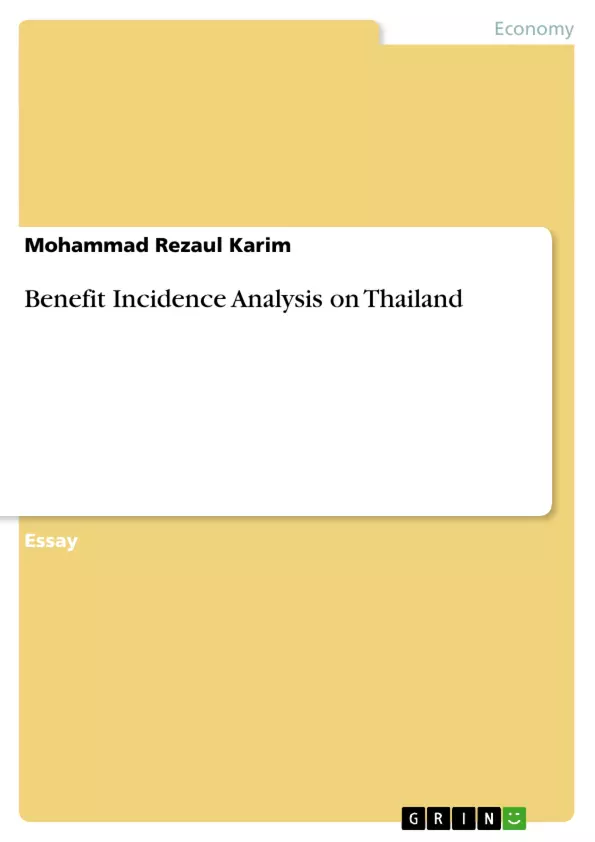Abstract: To reduce inequality in income distribution and reduce the poverty social welfare spending in Thailand particularly on education and health services is regarded as one of the effective instruments. Policy makers agree that public subsidies on education and health produce positive externalities and have spill over effect in the society. This research is designed to analyse the effects of public spending of education and health on income distribution which examine the pre-expenditure and post-expenditure income distribution in Thailand. It follows the benefit incidence analysis (BIA) that is a method of computing the distribution of public expenditure across different demographic groups, such as women and men. The procedure involves allocating per unit public subsidies (for example, expenditure per student for the education sector) according to individual utilization rates of public services. This paper aims at examine who are the real beneficiaries from the government expenditure. The study uses the quantitative method where data are used of 2010. From the benefit incidence analysis on the public expenditure on education it seems that education system is pro-poor and health care system are not pro-poor rather pro-rich. The poor people can be benefited more from the primary and secondary education and less benefited from the tertiary education. However, overall expenditure on education is favourable to the poor which proves from the income share of household. In this perspective, The Thai government should emphasize on higher education for poor by providing special loan created only for them and universities should also be adopted the policy so that poor income class people can access the opportunity. Government can increase the charge and fees for private higher education where normally rich households send their children. By doing so, government can earn more and spend for poor people. Regarding the healthcare system, Thai government should emphasize on preventive care than curative from which the whole nation will be benefitted. The programmes should be continued and more expenditure should be added to this. Government should charge tax on private healthcare system that will help collect more money and invest for the poor people. Since rich tends to go to the private hospitals, government will take money from the rich and spend for poor people. This process will minimize the income inequality.
Inhaltsverzeichnis (Table of Contents)
- Introduction
- Objective of the Study
- Significance of the Research
- An Overview of Education System and Health Care Service in Thailand and Public Spending
- Education System in Thailand
- Education Spending in Thailand
- Health Care System in Thailand
Zielsetzung und Themenschwerpunkte (Objectives and Key Themes)
This research paper aims to analyze the impact of public spending on education and health services on income distribution in Thailand. The study examines the pre-expenditure and post-expenditure income distribution, focusing on the effectiveness of public spending in achieving equitable benefits across income groups.- Distribution of Public Spending on Education and Health Services in Thailand
- Impact of Public Spending on Income Inequality
- Effectiveness of Education and Healthcare Spending in Reaching Different Income Groups
- Analysis of Gini Coefficient and Lorenz Curve for Measuring Income Inequality
- Policy Recommendations based on the Analysis of Distributional Effects
Zusammenfassung der Kapitel (Chapter Summaries)
The introduction provides context on social welfare spending in Thailand, specifically on education and health services. It highlights the common argument that public subsidies are needed to correct market imperfections and benefit the poor, as well as the potential spillover effects on economic growth and employment opportunities. The research objective is outlined, focusing on examining how public spending on education and health services is distributed in Thailand, especially considering the effectiveness of education spending in reaching both rich and poor groups. The significance of the research is discussed, emphasizing its contribution to policy analysis and providing researchers and policymakers with insights into the actual beneficiaries of public spending and the impact on income inequality. The paper then delves into an overview of the Thai education system and healthcare service. It highlights the government's emphasis on education, particularly after the enactment of the National Education Act of 1999, and the various types of education offered (formal, non-formal, and informal). The paper traces the evolution of education policy and spending in Thailand over the last few decades, highlighting initiatives such as expanding compulsory education and introducing student loan programs. The section also explores the challenges associated with ensuring equitable access to education for all income groups. The section on healthcare in Thailand details its evolution towards universal coverage, focusing on the government's increased budget allocation to primary and secondary health programs. It mentions initiatives taken to improve healthcare for the poor, such as low-income schemes.- Quote paper
- Mohammad Rezaul Karim (Author), 2013, Benefit Incidence Analysis on Thailand, Munich, GRIN Verlag, https://www.grin.com/document/213197



